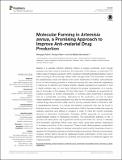Por favor, use este identificador para citar o enlazar a este item:
http://hdl.handle.net/10261/249393COMPARTIR / EXPORTAR:
 SHARE SHARE
 CORE
BASE CORE
BASE
|
|
| Visualizar otros formatos: MARC | Dublin Core | RDF | ORE | MODS | METS | DIDL | DATACITE | |

| Título: | Molecular farming in Artemisia annua, a promising approach to improve anti-malarial drug production |
Autor: | Pulice, Giuseppe; Pelaz, Soraya CSIC ORCID; Matías‐Hernández, Luis CSIC ORCID | Fecha de publicación: | 2016 | Editor: | Frontiers Media | Citación: | Frontiers in Plant Science 7: 239 (2016) | Resumen: | Malaria is a parasite infection affecting millions of people worldwide. Even though progress has been made in prevention and treatment of the disease; an estimated 214 million cases of malaria occurred in 2015, resulting in 438,000 estimated deaths; most of them occurring in Africa among children under the age of five. This article aims to review the epidemiology, future risk factors and current treatments of malaria, with particular focus on the promising potential of molecular farming that uses metabolic engineering in plants as an effective anti-malarial solution. Malaria represents an example of how a health problem may, on one hand, influence the proper development of a country, due to its burden of the disease. On the other hand, it constitutes an opportunity for lucrative business of diverse stakeholders. In contrast, plant biofarming is proposed here as a sustainable, promising, alternative for the production, not only of natural herbal repellents for malaria prevention but also for the production of sustainable anti-malarial drugs, like artemisinin (AN), used for primary parasite infection treatments. AN, a sesquiterpene lactone, is a natural anti-malarial compound that can be found in Artemisia annua. However, the low concentration of AN in the plant makes this molecule relatively expensive and difficult to produce in order to meet the current worldwide demand of Artemisinin Combination Therapies (ACTs), especially for economically disadvantaged people in developing countries. The biosynthetic pathway of AN, a process that takes place only in glandular secretory trichomes of A. annua, is relatively well elucidated. Significant efforts have been made using plant genetic engineering to increase production of this compound. These include diverse genetic manipulation approaches, such as studies on diverse transcription factors which have been shown to regulate the AN genetic pathway and other biological processes. Results look promising; however, further efforts should be addressed toward optimization of the most cost-effective biofarming approaches for synthesis and production of medicines against the malaria parasite. | Versión del editor: | http://dx.doi.org/10.3389/fpls.2016.00329 | URI: | http://hdl.handle.net/10261/249393 | DOI: | 10.3389/fpls.2016.00329 | E-ISSN: | 1664-462X |
| Aparece en las colecciones: | (CRAG) Artículos |
Ficheros en este ítem:
| Fichero | Descripción | Tamaño | Formato | |
|---|---|---|---|---|
| moleproduc.pdf | 892,17 kB | Adobe PDF |  Visualizar/Abrir |
CORE Recommender
PubMed Central
Citations
13
checked on 01-may-2024
SCOPUSTM
Citations
35
checked on 01-may-2024
WEB OF SCIENCETM
Citations
21
checked on 26-feb-2024
Page view(s)
73
checked on 02-may-2024
Download(s)
111
checked on 02-may-2024

